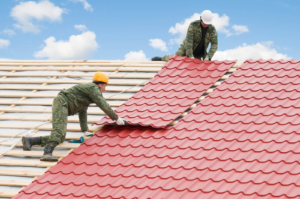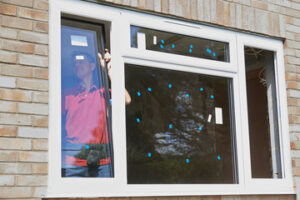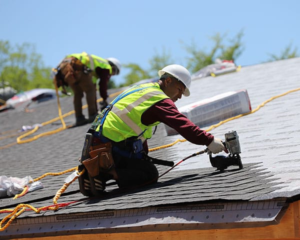The roof of a building protects its interior from rain, snow, wind and sunlight. It also provides insulation and enhances its aesthetic appeal.
A roof’s frame consists of rafters or prefabricated trusses, with sheathing boards (often plywood or oriented strand board) fastened to them. Shingles are then installed on top of the sheathing. Contact Erie Roofing now!

A flat roof is a roof that is almost level in contrast to the many types of sloped roofs. The slope of a roof is properly known as its pitch, and it serves two purposes: first it helps drain water off the roof; second, it adds some insulation against heat and cold. There are a variety of materials that can be used to construct a flat roof. Factors that will influence the type of material to use include geography, budget and the intended uses for the roof.
A common option for flat roofing is EPDM rubber. This is a durable synthetic material that offers up to 50 years of service. It is available in various colors and is easy to work with. Other options for flat roofs include PVC plastic and TPO (thermoplastic polyolefin) membranes. These materials offer energy efficiency properties, as they reflect the sun’s rays instead of absorbing them.
Another advantage of a flat roof is the availability of space for unique applications. A rooftop patio or garden can be a beautiful and relaxing addition to any home. Additionally, a flat roof can be used to support solar panels, which reduce a house’s carbon footprint.
If a flat roof is not constructed or maintained correctly, it can develop serious problems, including leakage and rot. The most common cause of these problems is a lack of adequate drainage. This occurs when gravel, leaves or other debris block spigots, drains, downpipes or gutters. This results in water ponding, which can eventually lead to structural damage and mold.
The most important aspect of a flat roof is proper maintenance and inspection. This should be done at least twice a year, and it is especially important after heavy rains or snowfall. This will help prevent water ponding and other problems that can significantly shorten a flat roof’s lifespan. In addition, it is important to have the correct ventilation to prevent moisture buildup. Lastly, it is a good idea to have the roof inspected by a professional before beginning any repairs or modifications. The expert can make recommendations based on the specific needs of the roof.
Agable Roof
Whether you’re building a new home or replacing an existing roof, the type of roofing you choose will have a major impact on your property and its protection. Among the most common and economical styles is the gable roof. This design features two roof planes that meet at a peak or ridge in the middle, and it can be either steep or shallow. Gable roofs are ideal for shedding precipitation, and they’re easy to frame and construct.
You can find gable roofs on homes of all shapes and sizes, including modern and traditional designs. They can be used to create distinctive architectural styles, and they’re a good choice for areas with heavy rainfall. Gable roofs are also efficient to ventilate, which helps reduce the risk of a leaky or damaged roof. Additionally, the shape of a gable roof often creates attic space that can be used for storage or future expansion.
Another advantage of a gable roof is that it can be built with various materials, making it versatile and customizable to your needs. For example, you can use asphalt shingles, metal sheets, clay and concrete tiles or cedar shake, all of which offer different weather-resistant properties. Ultimately, the best material for your roof will depend on your climate and personal preference.
A gable roof can be designed to include dormers, valleys and varying pitches to suit your individual tastes. You can also add a curved eaves for a more unique look. The ridge of a gable roof typically extends out from the house, creating an overhang that protects it from rain and snow.
Like all roofs, a gable roof will require maintenance over time. It’s important to have a reliable roofing contractor to perform regular inspections and make any necessary repairs. In addition, you should consider scheduling an annual shingle replacement with your contractor to ensure your roof is properly maintained and protected from damage. This will help you avoid any costly repair bills in the future.
Sloped Roof
As the name suggests, a sloping roof features a sloped surface that allows rainwater, snow, and debris to easily flow down the structure, preventing potential damage from water pooling or structural issues. Sloped roofs typically feature a more pronounced incline than flat roofs, and the precise slope of a particular roof is determined by a number of factors including climate, design, and roofing materials.
The degree of a roof’s slope is usually measured as the ratio of vertical rise to horizontal run and can be expressed in inches per foot or with a ratio such as 6/12 (or 6:12). The higher the roof’s pitch, the more precipitation it sheds and the less chance of water pooling that leads to structural and environmental problems.
Sloped roofs also provide better ventilation opportunities than flat roofs and often feature an attic that is ideal for storage or other purposes. The lack of an attic with flat roofs can, however, create moisture concerns that are often more serious than those associated with a sloping roof’s moisture control, and the lack of adequate ventilation can lead to the growth of mold and other organic material.
A sloping roof can be covered in a wide range of roofing materials, from traditional shingles to more intricate mansard designs, offering a wide array of aesthetic choices for homeowners and architects. Some of the most common sloped roofs are constructed from asphalt shingles, which are durable and affordable, and can provide a traditional look that complements many architectural styles.
Other sloped roofs are constructed from more premium roofing materials, such as slate tile and wood shakes. These roofing materials offer a unique, beautiful aesthetic but require the skill of a highly-skilled roofing contractor and may have more expensive installation costs. Sloped roofs of all types can also be built with a variety of solar panels, which help reduce energy costs while improving the structure’s overall environmental performance. In any case, a roofing professional can guide the homeowner or business owner on the best roofing style for their building.
Tile Roof
Tile roofs add beauty to a home, with a distinctive and high-end appearance that can boost curb appeal. They are also very durable, lasting for up to 100 years. This longevity and durability can result in lower heating and cooling costs, especially when compared to asphalt shingle roofs.
Tile can be made from clay or concrete and is available in a wide range of styles and colors to match any architectural design. There are even textured styles to mimic wood shake and slate roofing. A tile roof’s natural properties also provide insulation, regulating indoor temperatures.
One of the primary reasons homeowners choose a tile roof is because it is highly resistant to fire and withstands harsh weather conditions, including wind, hail, and heavy rain. These features make tile an ideal choice for homes in hot climates where other roofing materials may wear down or break quickly.
A downside to a tile roof is the higher cost compared to other roofing materials. However, this can be offset by its long lifespan and energy-saving benefits.
Like other types of roofing, a tile roof requires regular maintenance to keep it in good condition. This depends on the environment and the type of tiles, and includes inspecting for damage, cleaning, and removing any debris or leaves that have collected.
Tile roofs are also very heavy, which is why they require a sturdy roof framing system to support their weight. This is important to prevent any structural problems with your roof, and should be performed by a professional roofing contractor.
Another important consideration is that tile roofs can be damaged by foot traffic, falling objects, and other factors. For this reason, it is best to limit foot traffic on your tile roof and have a professional perform regular inspections. In addition, if you have a tile roof, it is essential to protect the surface with a quality felt underlayment. This can protect the underside of your roof and prevent any water leaks. If you are considering a tile roof, it is important to consult with a qualified roofing contractor to discuss your options and budget.

